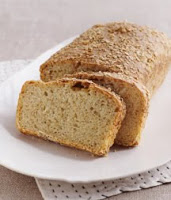To see the video on making this Easy Oat Bread
recipe go here.

Easy Oat Bread From
Kneadlessly Simple:
Fabulous, Fuss-free, No-knead Breads
If you’re looking for my Crusty White Pot Boule (it’s my own improved version of the one first published in the NY Times), click here. Or try another crusty, artisan-style loaf from Kneadlessly Simple, my rustic Crusty Seeded Pale Ale Boule here.
![]()
5 1/2 cups (27.5 ounces) unbleached all-purpose white flour or white bread flour, plus more as needed
1 cup old-fashioned rolled oats or quick cooking (not instant) oats, plus 4 tablespoons for garnish
3 tablespoons granulated sugar
Scant 2 3/4 teaspoons table salt
1 teaspoon instant, fast-rising, or bread machine yeast
1/4 cup clover honey or light (mild) molasses
1/4 cup corn oil or other flavorless vegetable oil, plus extra for coating dough tops and baking pans
2 1/4 cups plus 2 tablespoons ice water, plus more if needed
First rise: In a very large bowl, thoroughly stir together the flour, oats, sugar, salt, and yeast. In a large measuring cup, thoroughly whisk the honey and oil into the water. Thoroughly stir the mixture into the bowl, scraping down the sides until the ingredients are thoroughly blended. If the mixture is too dry to incorporate all the flour, stir in just enough more water to blend the ingredients; don’t over-moisten, as the dough should be slightly stiff. Brush or spray the top with oil. Cover the bowl with plastic wrap. If desired, for best flavor or convenience, you can refrigerate the dough for 3-10 hours; this is optional. Then let rise at cool room temperature for 12-18 hours.
Second rise: Vigorously stir the dough. If necessary, stir in enough more flour to yield a hard-to-stir consistency. Generously oil two 8 1/2 x 4 1/2-inch loaf pans. Sprinkle a tablespoon of oats in each; tip the pans back and forth to spread the oats over the bottom and sides. Use well oiled kitchen shears or a serrated knife to cut the dough into 2 equal portions. Put the portions in the pans. Brush or spray the tops with oil. Press and smooth the dough evenly into the pans with an oiled rubber spatula or fingertips. Sprinkle a tablespoon of oats over each loaf; press down to imbed. Make a 1/2-inch deep slash lengthwise down the center of each loaf using oiled kitchen shears or a serrated knife. Tightly cover the pans with nonstick spray-coated plastic wrap.
Let rise using any of these methods: for a 2- to 3-hour regular rise, let stand at warm room temperature; for a 45-minute to 2-hour accelerated rise, let stand in a turned-off microwave along with 1 cup of boiling-hot water; or for an extended rise, refrigerate, covered, for 4 to 24 hours, then set out at room temperature. Continue the rise until the dough nears the plastic. Remove it and continue until the dough extends 1/2 inch above the pan rims.
Baking: 15 minutes before baking time, place a rack in the lower third of the oven; preheat to 375 degree F.Bake on the lower rack for 50 to 60 minutes, until the tops are well-browned. Cover the tops with foil. Bake 10 to 15 minutes more until a skewer inserted in the thickest part comes out with just a few particles clinging to the bottom portion (or until the center registers 208 to 210 degree F on an instant-read thermometer). Bake for 5 minutes longer to be sure the centers are done. Let cool in the pans on a wire rack for 15 minutes. Turn out the loaves onto racks and cool thoroughly.
Yield: 2 medium loaves, about 12 slices each

Comments